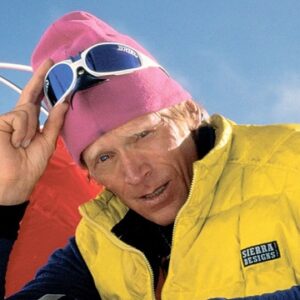Anatoli Boukreev was a Russian mountaineer who, throughout his lifetime, ascended some of the world’s highest peaks. In comparison to his contemporaries, he was one of the strongest mountaineers of all time, with incredible stamina. He made some of the most amazing ascents in mountain climbing history, including several without the use of supplemental oxygen. Avalanches, landslides, blizzards, and a slew of other mountaineering hazards put his missions in jeopardy, but his love for the mountains outweighed any barriers in his path. He climbed seven of the fourteen eight-thousander peaks, or those exceeding 8,000 meters, without the need of supplemental oxygen. His heroic efforts to save fellow climbers on Mount Everest during the 1996 blizzard are regarded as one of the greatest shows of heroism and determination in mountaineering rescue history. However, his adventurous life came to an end when he was killed in an avalanche while climbing Mount Annapurna in Nepal. His body was never found, which may be seen as his final gesture of dedication to the mountains, his cathedral. He viewed the mountains as his place of worship, and his enthusiasm for mountaineering, which finally claimed his life, made him immortal.
Childhood and Adolescence
He was born into a poor family in Korkino, Russia, on January 16, 1958. In 1975, he graduated from high school.
He studied at Chelyabinsk University for Pedagogy after high school and finished with a Bachelor of Science degree in physics in 1979. He also completed his cross-country skiing course at the same time.
He relocated to Kazakhstan after graduation and joined a Kazakhstani mountaineering team in 1985 to pursue his goal of mountaineering.
The Career of Anatoli
He made his first solo climb of Lenin Peak (7,134 m) on the Tajikistan-Kyrgyzstan border in 1987.
With the ‘Second Soviet Himalaya Expedition,’ he climbed Kangchenjunga (8556 m), the world’s third-highest peak, through a new route in 1989.
In 1990, he joined American climbers on Mt. McKinley, commonly known as Denali, North America’s tallest mountain peak, with a summit elevation of 6168 meters above sea level. The expedition was successful, and he conducted a solo fast ascent of Mt. McKinley after the team returned.
He completed his first climbing expedition to the world’s highest peak, Mount Everest (8,848 m), via the South Col route in 1991.
With Peter Metzger and Andy Locke, he led the ascent of K2 (8611 m), the world’s second-highest mountain, via the Abruzzi Spur, in 1993. During the ascent, he was put in a risky situation when his teammates advised hiking to the summit without stopping, but he was fatigued and out of energy.
He was hesitant at first, but consented to climb; as a result, when he reached the summit, he was physically and emotionally exhausted, and he did not experience the thrill of success.
He climbed the Makalu (8476 m), the world’s fifth tallest mountain, which is shaped like a four-sided pyramid, in 1994.
He set the fastest ascent record on Dhaulagiri (8,167 m) in 1995, clocking in at 17 hours 15 minutes. In the same year, he ascended Mount Everest for the second time, this time by the North Ridge route.
He was the lead climbing guide on Scott Fisher’s ‘Mountain Madness expedition to Mount Everest in 1996, which aimed to reach the summit in one day.
Upon reaching the summit, they were met by a devastating blizzard, which claimed several lives, including Fisher’s. With his brave move, Boukreev was able to save several of the climbers from the calamity.
He achieved the solo ascent of Lhotse (8516 m), the world’s fourth-highest mountain, after returning from Everest.
In 1997, he climbed Annapurna I (8091 m), the world’s tenth highest Himalayan peak, with Simone Moro and Dimitri Sobolev by his side. An avalanche struck them at an elevation of 5,700 meters, killing Boukreev and Sobolev.
Despite his serious injuries, Moro managed to return to the Annapurna base camp and was transported to Kathmandu for surgery.
Achievements & Awards
He planned to undertake a solo ascent of Mt. McKinley, North America’s highest mountain peak, in 1990. In a 1990 issue of ‘Climbing,’ the magazine highlighted that he completed his ascent in a record time of 10.5 hours from the base to the top.
During his 1996 trek to Mount Everest, he saved three trapped climbers from a blizzard that attacked them as soon as they reached the summit. It was dubbed “one of the most incredible rescues in climbing history,” and he was lauded for his bravery.
In 1997, he received the American Alpine Club’s highest medal for gallantry, the ‘David A. Sowles Memorial Award,’ for his heroic involvement in rescuing three climbers after the 1996 Everest accident.
Personal History and Legacy
He became a citizen of the Kazakhstan Republic in 1991, following the disintegration of the Soviet Union.
He died in an avalanche during a winter ascent of Annapurna in Nepal on December 25, 1997.
Linda Wylie, his girlfriend, came to Kathmandu in the hopes of locating and rescuing him. However, when she arrived, she confirmed that there was no hope of finding him alive. His remains were never discovered.
Estimated Net worth
His net worth is believed to be $4 million.


